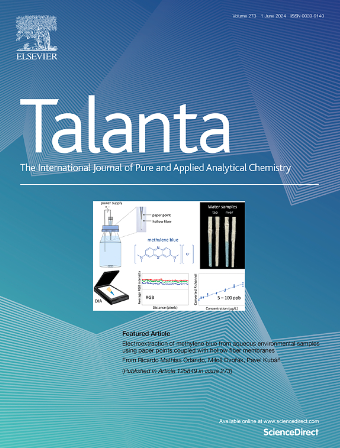便携式原子荧光光谱法现场测定天然水中总溶解无机砷
IF 5.6
1区 化学
Q1 CHEMISTRY, ANALYTICAL
引用次数: 0
摘要
在不同的环境基质中测定总砷仍然是一个重大挑战。为了解决传统实验室分析方法中固有的复杂场矩阵的时空延迟和干扰问题,本研究开发了一个连续、自动化和长期的总溶解无机砷(TDIAs)监测系统。该系统可以在线实时监测天然水体中的tdia。通过优化仪器参数和化学蒸汽生成条件,深入研究了As(Ⅴ)预还原过程的反应动力学过程。此外,设计了天然水体中TDIAs的现场测定流程,包括在线过滤、样品酸化、预还原、分析检测和单点校准。结果表明,该方法的检出限(LOD)低至0.005 μg/L,在最佳参数条件下线性范围为0.0 ~ 5.0 μg/L,相对标准偏差(rsd)在0.6% ~ 7.3%范围内,具有良好的分析精度。方法验证表明,自来水、湖水、海水等不同基质样品的回收率稳定在97.8% ~ 107.8%范围内,证明该方法具有良好的抗基质干扰能力。最后,将该方法成功应用于泉州湾锦江口TDIAs的现场测定。本文章由计算机程序翻译,如有差异,请以英文原文为准。

On-site determination of total dissolved inorganic arsenic in natural waters by a portable atomic fluorescence spectroscopy
The determination of total arsenic across diverse environmental matrices remains a significant challenge. To address the spatial and temporal delays and interference from complex field matrices inherent in traditional laboratory analysis methods, this study developed a continuous, automated, and long-term monitoring system for total dissolved inorganic arsenic (TDIAs). The system enables on-line real-time monitoring of TDIAs in natural waters. Through optimizing the instrumental parameters and chemical vapor generation conditions, the reaction kinetic process of As(Ⅴ) pre-reduction process was thoroughly investigated. In addition, a workflow for the on-site determination of TDIAs in natural waters was designed, including on-line filtration, sample acidification, pre-reduction, analytical detection and single-point calibration. The results demonstrated that the limit of detection (LOD) reached as low as 0.005 μg/L, with a linear range of 0.0–5.0 μg/L under the optimal parameter conditions, and the relative standard deviations (RSDs) were in the range of 0.6 %–7.3 %, which demonstrated a good analytical precision. The method validation showed that the recoveries of different matrix samples, such as tap water, lake water and seawater, were stable in the range of 97.8 %–107.8 %, which proved that the method has excellent ability of resisting matrix interference. Finally, the method has been successfully applied to the on-site determination of TDIAs in the Jinjiang River Estuary, Quanzhou Bay.
求助全文
通过发布文献求助,成功后即可免费获取论文全文。
去求助
来源期刊

Talanta
化学-分析化学
CiteScore
12.30
自引率
4.90%
发文量
861
审稿时长
29 days
期刊介绍:
Talanta provides a forum for the publication of original research papers, short communications, and critical reviews in all branches of pure and applied analytical chemistry. Papers are evaluated based on established guidelines, including the fundamental nature of the study, scientific novelty, substantial improvement or advantage over existing technology or methods, and demonstrated analytical applicability. Original research papers on fundamental studies, and on novel sensor and instrumentation developments, are encouraged. Novel or improved applications in areas such as clinical and biological chemistry, environmental analysis, geochemistry, materials science and engineering, and analytical platforms for omics development are welcome.
Analytical performance of methods should be determined, including interference and matrix effects, and methods should be validated by comparison with a standard method, or analysis of a certified reference material. Simple spiking recoveries may not be sufficient. The developed method should especially comprise information on selectivity, sensitivity, detection limits, accuracy, and reliability. However, applying official validation or robustness studies to a routine method or technique does not necessarily constitute novelty. Proper statistical treatment of the data should be provided. Relevant literature should be cited, including related publications by the authors, and authors should discuss how their proposed methodology compares with previously reported methods.
 求助内容:
求助内容: 应助结果提醒方式:
应助结果提醒方式:


